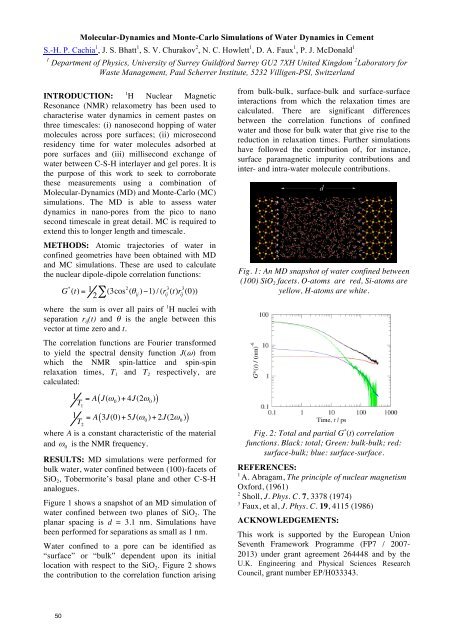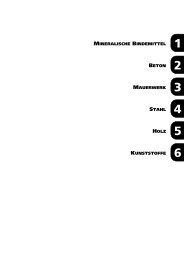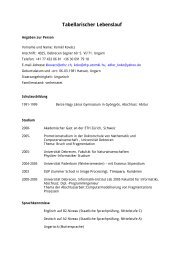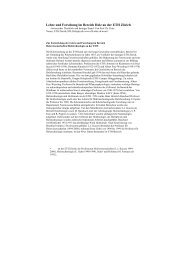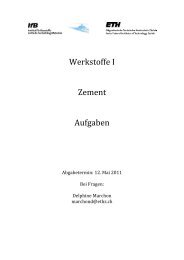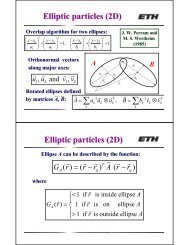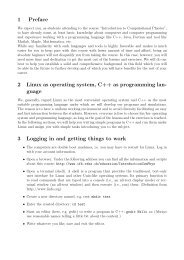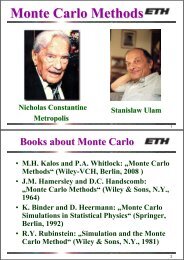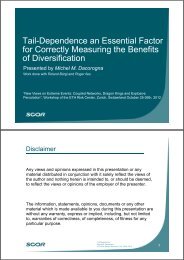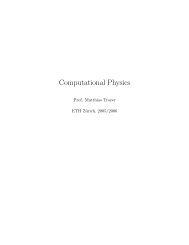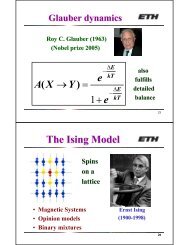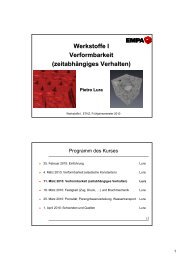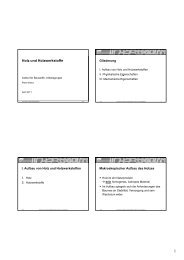Here - Institute for Building Materials - ETH Zürich
Here - Institute for Building Materials - ETH Zürich
Here - Institute for Building Materials - ETH Zürich
You also want an ePaper? Increase the reach of your titles
YUMPU automatically turns print PDFs into web optimized ePapers that Google loves.
Molecular-Dynamics and Monte-Carlo Simulations of Water Dynamics in CementS.-H. P. Cachia 1 , J. S. Bhatt 1 , S. V. Churakov 2 , N. C. Howlett 1 , D. A. Faux 1 , P. J. McDonald 11 Department of Physics, University of Surrey Guild<strong>for</strong>d Surrey GU2 7XH United Kingdom 2 Laboratory <strong>for</strong>Waste Management, Paul Scherrer <strong>Institute</strong>, 5232 Villigen-PSI, SwitzerlandINTRODUCTION:1 H Nuclear MagneticResonance (NMR) relaxometry has been used tocharacterise water dynamics in cement pastes onthree timescales: (i) nanosecond hopping of watermolecules across pore surfaces; (ii) microsecondresidency time <strong>for</strong> water molecules adsorbed atpore surfaces and (iii) millisecond exchange ofwater between C-S-H interlayer and gel pores. It isthe purpose of this work to seek to corroboratethese measurements using a combination ofMolecular-Dynamics (MD) and Monte-Carlo (MC)simulations. The MD is able to assess waterdynamics in nano-pores from the pico to nanosecond timescale in great detail. MC is required toextend this to longer length and timescale.M<strong>ETH</strong>ODS: Atomic trajectories of water inconfined geometries have been obtained with MDand MC simulations. These are used to calculatethe nuclear dipole-dipole correlation functions:G * (t) = 1 (3cos 2 (! 2 ! ij)"1) / (r 3 ij(t)r 3 ij(0))where the sum is over all pairs of 1 H nuclei withseparation r ij (t) and θ is the angle between thisvector at time zero and t.The correlation functions are Fourier trans<strong>for</strong>medto yield the spectral density function J(!) fromwhich the NMR spin-lattice and spin-spinrelaxation times, T 1 and T 2 respectively, arecalculated:1 = A J(!T1( 0)+ 4J(2! 0))1 = A 3J(0)+ 5J(!T2( 0)+ 2J(2! 0))where A is a constant characteristic of the materialand ! 0is the NMR frequency.RESULTS: MD simulations were per<strong>for</strong>med <strong>for</strong>bulk water, water confined between (100)-facets ofSiO 2 , Tobermorite’s basal plane and other C-S-Hanalogues.Figure 1 shows a snapshot of an MD simulation ofwater confined between two planes of SiO 2 . Theplanar spacing is d = 3.1 nm. Simulations havebeen per<strong>for</strong>med <strong>for</strong> separations as small as 1 nm.Water confined to a pore can be identified as“surface” or “bulk” dependent upon its initiallocation with respect to the SiO 2 . Figure 2 showsthe contribution to the correlation function arisingfrom bulk-bulk, surface-bulk and surface-surfaceinteractions from which the relaxation times arecalculated. There are significant differencesbetween the correlation functions of confinedwater and those <strong>for</strong> bulk water that give rise to thereduction in relaxation times. Further simulationshave followed the contribution of, <strong>for</strong> instance,surface paramagnetic impurity contributions andinter- and intra-water molecule contributions.Fig. 1: An MD snapshot of water confined between(100) SiO 2 facets. O-atoms are red, Si-atoms areyellow, H-atoms are white.Fig. 2: Total and partial G * (t) correlationfunctions. Black: total; Green: bulk-bulk; red:surface-bulk; blue: surface-surface.REFERENCES:1A. Abragam, The principle of nuclear magnetismOx<strong>for</strong>d, (1961)2 Sholl, J. Phys. C. 7, 3378 (1974)3 Faux, et al, J. Phys. C. 19, 4115 (1986)ACKNOWLEDGEMENTS:This work is supported by the European UnionSeventh Framework Programme (FP7 / 2007-2013) under grant agreement 264448 and by theU.K. Engineering and Physical Sciences ResearchCouncil, grant number EP/H033343.50


